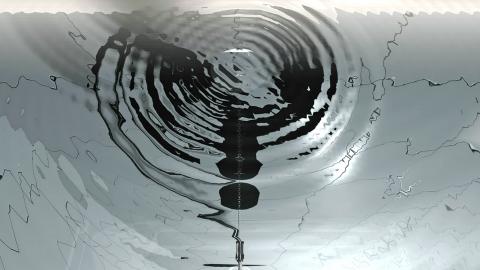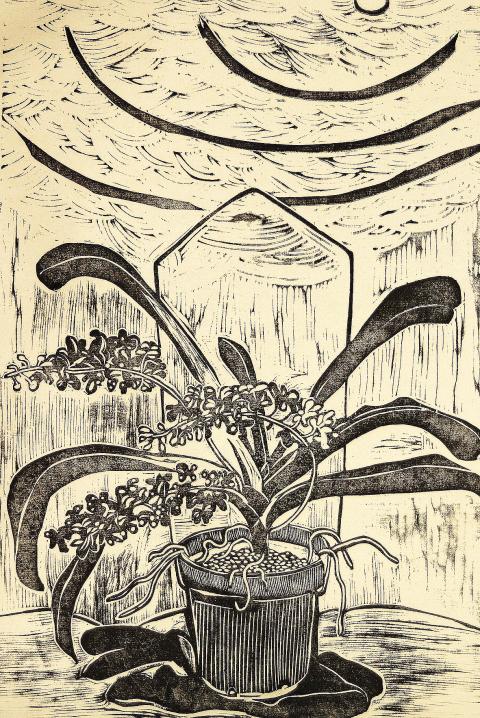After graduating with a double degree in physics and engineering, Taiwan-born, Australian-raised Annie Wang Hsiao-wen (王筱雯) worked at a mining company in Australia, but felt that it just wasn’t her calling. Soon after, Wang started painting abstract scenes, utilizing warm colors and earthy hues in order to produce a billowing effect. Wang, who says she draws inspiration from Buddhism and meditation, captures this in her paintings, most of which have a mysterious, transcendental quality. Her latest exhibition, Seek (覓), which is currently on display at Yesart Air Gallery in Taipei, showcases 17 of her newest works.
■ Yesart Air Gallery (意識畫廊), 2F, 48, Zhongshan N Rd Sec 7, Taipei City (台北市中山北路七段48號2樓), tel: (02) 2876-3858. Open Tuesdays to Sundays from 2pm to 8pm
■ Until Sept. 15

Photo courtesy of Frees Art Space
German artistic duo Marc Weis and Martin De Mattia, who refer to themselves simply as M+M, have been producing short films together for the last 20 years. Their latest exhibition, Bittersweet Harmony, is set to open at Taipei’s VT Art Salon tomorrow, and will include screenings of their most noted work, 7 days. Filmed over the course of seven years, 7 days chronicles the daily life of a solitary man, emphasizing how he interacts with people. His actions are juxtaposed on two separate screens. There’s one scene where he’s lying in bed with his naked girlfriend and another with his young daughter in her underwear. The dialogue is exactly the same — they’re both asking the actor if he loves them or not — but his tone of voice is discernibly different in each situation (although that doesn’t make it any less disturbing). The exhibition space itself is also important to the artists who see it as part of their “canvas,” where the colors of the walls match with the hues in the film.
■ VT Art Salon (非常廟藝文空間), B1, 47 Yitong St, Taipei City (台北市伊通街47號B1), tel: (02) 2516-1060. Open Tuesdays through Thursdays from 1:30pm to 9pm, and Fridays and Saturdays from 1:30pm to 10pm
■ Opens tomorrow. Until Sept. 19

Photo courtesy of Annie Wang
MBMore, a printmaking arts and crafts store in Taipei’s Datong District (大同區) that regularly showcases cute and quirky artwork, is currently exhibiting Midsummer Night (林夏), a solo exhibition by Hsu Jui-zhi (徐睿志), who prefers to go by the name Muran (沐冉). Plants, pets and barnyard animals are among Muran’s favorite subject matters. While some of his carvings are etched in black and white, others are vibrant and colorful. Yet all of his prints have a domestic, sometimes humorous feel — for instance, a startled-looking Chihuahua wearing a hat, a cat clinging onto a fan that threatens to blow it away or a horse riding on another horse. His prints are definitely something I would hang on my wall if I had a country home with a barnyard-themed kitchen.
■ MBMore (岩筆模), 32-1, Chifeng St, Taipei City (台北市赤峰街32-1號); tel: (02) 2558-3395. Open Tuesday to Sundays from 1pm to 9pm
■ Until Sept. 27

Photo courtesy of MBMore
We rely so much on apps like Google Maps these days, putting our trust in gadgets and believing them to be infallible. An exhibition at Taipei’s Meme Space Gallery seeks to challenge this belief. The Depth of Appearances (表象的深度) consists of artwork by Hsu Xin-wen (許馨文), Chang Po-chieh (張博傑) and Zhao Pin-han (趙品函) that centers on questioning the fine line between appearance and reality. While Hsu’s main subject matter revolves around neighborhoods and living space, Chang tweaks Google Maps and Zhao recreates crime scenes by playing with color and perspective.
■ Meme Space (覓空間), 12F, 9, Roosevelt Rd Sec 2, Taipei City (台北市羅斯福路二段9號12樓); tel: (02) 2396-5505. Open Mondays to Saturdays from 11am to 6pm
■ Until Oct. 3
Frees Art Space in Taipei is currently holding an exhibition, Society of Spectacular (奇觀社會), to highlight work created by artists from the art collective known as Hantoo Art Group (悍圖社). Formed in 1998, the Hantoo Art Group examines Taiwan’s history, mythology and folk culture, often by employing dark humor. Among the artwork displayed are surrealist painter Kuo Wei-guo’s (郭維國) sinister and mythical depictions of himself and of severed animal heads, as well as Chu Hsu-hsien’s (朱書賢) creepy black-and-white 3D animations.
■ Frees Art Space (福利社), B1, 82, Xinsheng N Rd Sec 3, Taipei City (台北市新生北路三段82號B1); tel: (02) 2585-7600. Open Tuesdays to Fridays from 11am to 7pm, Saturdays 1:30pm to 9pm
■ Opens tomorrow. Until Oct. 8

In the March 9 edition of the Taipei Times a piece by Ninon Godefroy ran with the headine “The quiet, gentle rhythm of Taiwan.” It started with the line “Taiwan is a small, humble place. There is no Eiffel Tower, no pyramids — no singular attraction that draws the world’s attention.” I laughed out loud at that. This was out of no disrespect for the author or the piece, which made some interesting analogies and good points about how both Din Tai Fung’s and Taiwan Semiconductor Manufacturing Co’s (TSMC, 台積電) meticulous attention to detail and quality are not quite up to

Chinese Nationalist Party (KMT) Chairman Eric Chu (朱立倫) hatched a bold plan to charge forward and seize the initiative when he held a protest in front of the Taipei City Prosecutors’ Office. Though risky, because illegal, its success would help tackle at least six problems facing both himself and the KMT. What he did not see coming was Taipei Mayor Chiang Wan-an (將萬安) tripping him up out of the gate. In spite of Chu being the most consequential and successful KMT chairman since the early 2010s — arguably saving the party from financial ruin and restoring its electoral viability —

It is one of the more remarkable facts of Taiwan history that it was never occupied or claimed by any of the numerous kingdoms of southern China — Han or otherwise — that lay just across the water from it. None of their brilliant ministers ever discovered that Taiwan was a “core interest” of the state whose annexation was “inevitable.” As Paul Kua notes in an excellent monograph laying out how the Portuguese gave Taiwan the name “Formosa,” the first Europeans to express an interest in occupying Taiwan were the Spanish. Tonio Andrade in his seminal work, How Taiwan Became Chinese,

Toward the outside edge of Taichung City, in Wufeng District (霧峰去), sits a sprawling collection of single-story buildings with tiled roofs belonging to the Wufeng Lin (霧峰林家) family, who rose to prominence through success in military, commercial, and artistic endeavors in the 19th century. Most of these buildings have brick walls and tiled roofs in the traditional reddish-brown color, but in the middle is one incongruous property with bright white walls and a black tiled roof: Yipu Garden (頤圃). Purists may scoff at the Japanese-style exterior and its radical departure from the Fujianese architectural style of the surrounding buildings. However, the property